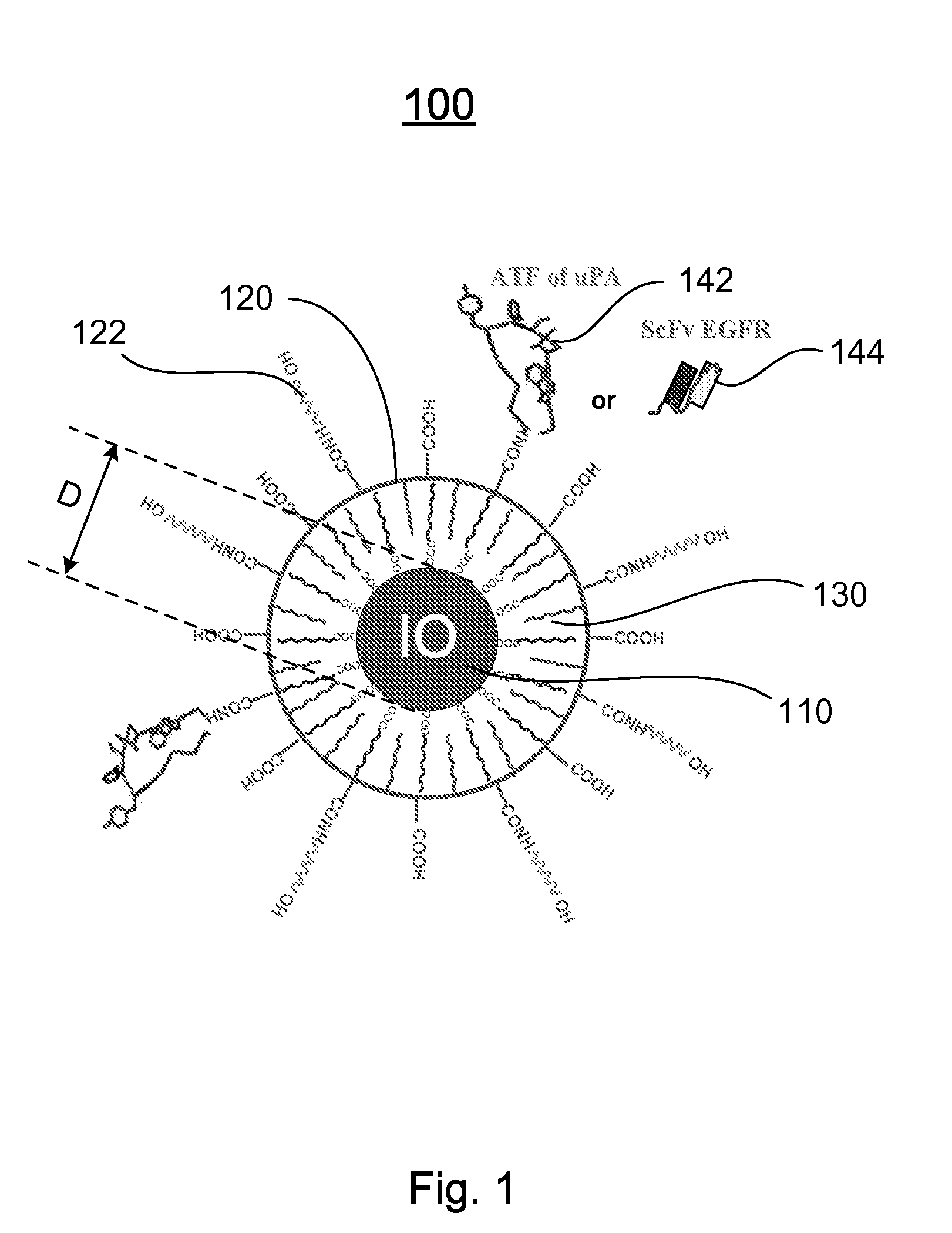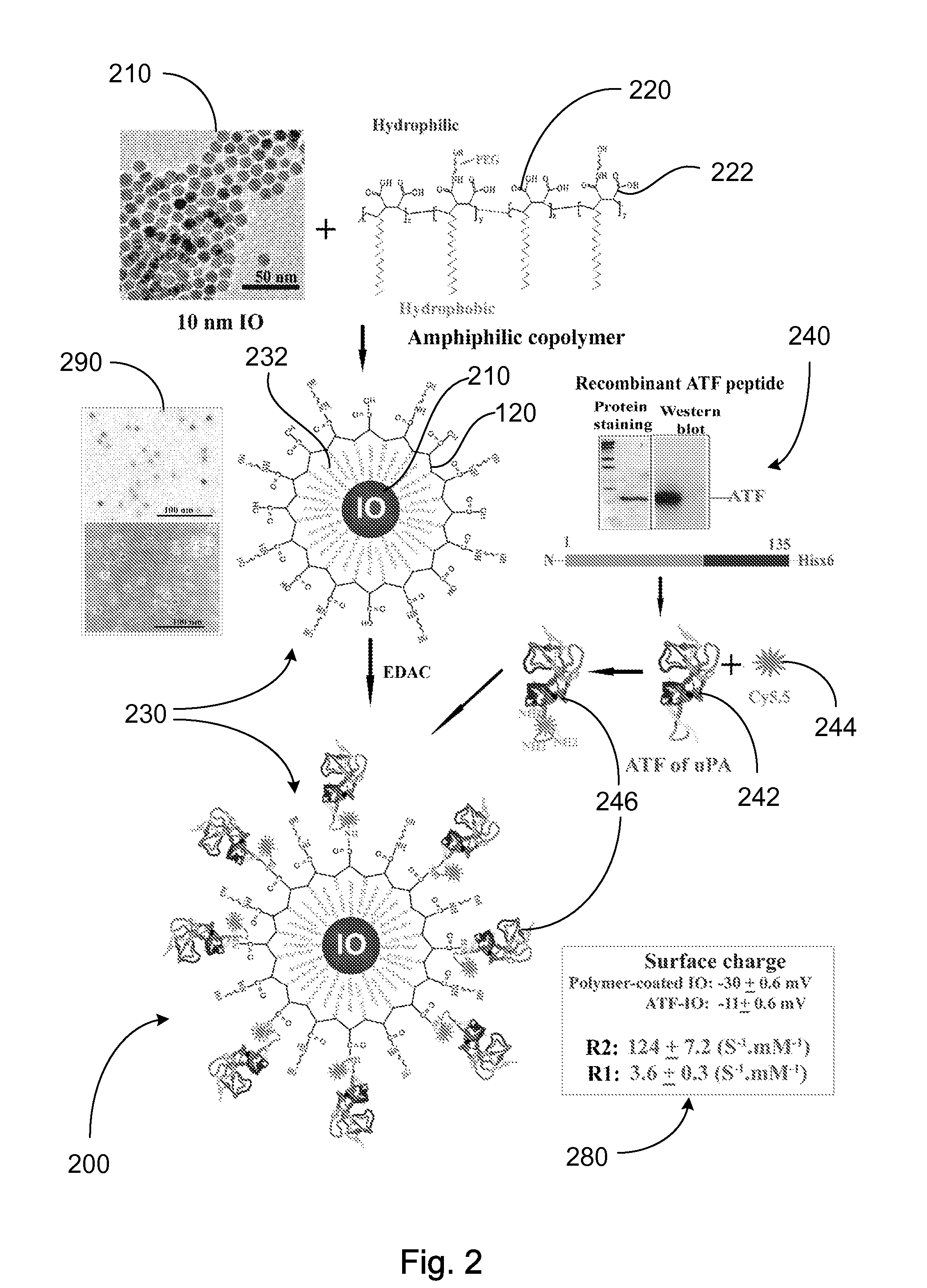Nanostructures, methods of synthesizing thereof, and methods of use thereof
a nanostructure and nanoparticle technology, applied in the field of nanostructures, can solve the problems of insufficient concentration of non-tumor targeted nanoparticles at tumor sites, limiting clinical application, and mortality in breast cancer patients
- Summary
- Abstract
- Description
- Claims
- Application Information
AI Technical Summary
Benefits of technology
Problems solved by technology
Method used
Image
Examples
example 1
Receptor-Targeted Nanoparticle for In Vivo Targeting and Non Invasive Imaging of Cancer
[0090]Breast Cancer Cell Lines: Mouse mammary carcinoma cell line 4T1B was provided by the Barbara Ann Karmanos Cancer Institute, Detroit, Mich. 4T1 cell line stable expressing a firefly luciferase gene was obtained by Duke University, Durham, N.C. Human breast cancer cell line T47D was purchased from American Type Culture Collection (ATCC, Rockville, Md.). 4T1 cells were grown in Dulbecco's modified Eagle's medium containing 10% fetal bovine serum (FBS). T47D cells were grown in RPMI 1640 containing 10% FBS, 100 ug / ml gentamicin, and 0.2 IU insulin / ml.
[0091]Engineering A TF-IO Nanoparticles: A cDNA fragment encoding amino acids 1-135 of mouse uPA, isolated by PCR amplification using a PCR primer pair containing forward (5′-CACCATGGGCAGTGTACTTGGAGCTCC-3′) and reverse (5′-GCTAAGAGAGCAGTCA-3′) primers, was cloned into pETIO 1 / D-TOPO expression vector (Invitrogen, Carlsbad, Calif....
example 2
Peptide Conjugated IO Nanoparticles for Targeted MR Imaging and Therapy of Pancreatic Cancer
[0120]Preparation of IO Nanoparticles with Functionalized Surface: IO was prepared by heating iron oxide powder and oleic acid in octadecene over 315° C. The size of IO was tuned through changes such as heating time, temperature, and concentration of the iron oxide and oleic acid [14]. IO nanoparticles with highly uniformed core sizes of 9 or 10 nm were used for this example. Amphiphilic polymers were coated to the surface to convert hydrophobic IO nanoparticles to stable, water soluble and biocompatible nanoparticles. The hydrocarbon chains of the polymer intercalate into the inner hydrophobic layer that stabilize IO nanoparticle surface while carboxylic acid groups in the out-layer make the IO nanoparticles hydrophilic and reactive for conjugating proteins, peptides or small molecules.
[0121]Engineering Tumor Targeted-IO Nanoparticles: A 135-amino acids of the ATF of mous...
PUM
| Property | Measurement | Unit |
|---|---|---|
| core size | aaaaa | aaaaa |
| temperature | aaaaa | aaaaa |
| size | aaaaa | aaaaa |
Abstract
Description
Claims
Application Information
 Login to View More
Login to View More - R&D
- Intellectual Property
- Life Sciences
- Materials
- Tech Scout
- Unparalleled Data Quality
- Higher Quality Content
- 60% Fewer Hallucinations
Browse by: Latest US Patents, China's latest patents, Technical Efficacy Thesaurus, Application Domain, Technology Topic, Popular Technical Reports.
© 2025 PatSnap. All rights reserved.Legal|Privacy policy|Modern Slavery Act Transparency Statement|Sitemap|About US| Contact US: help@patsnap.com



